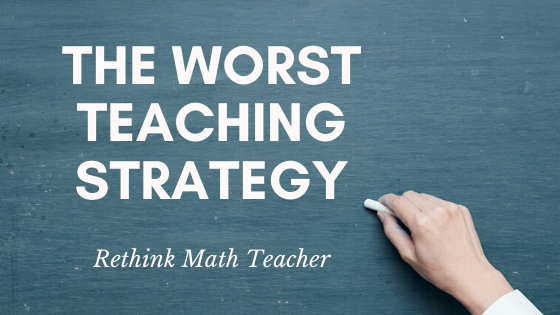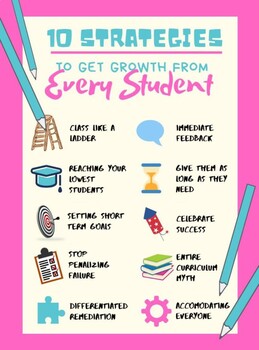
So “the worst” is a bit of hyperbole. I’m sure that there are worse strategies. But this is a strategy that I see lots of teachers utilizing and it is very unproductive. Not to mention that it’s a huge waste of time.
Football Illustration
I was the athletic director at my school when e started a middle school flag football team. I went to watch our fledgling team at practice and the coach was doing something that had to be corrected.
He had the whole team lined up, practicing deep routes. One at a time, each player would take a turn running a deep route while he threw them the ball.
Why is that so bad?
Practicing this way is super unproductive. What are all the other players doing while the one player ran the route and tried to catch the ball? The answer: nothing
What a waste of time.
And why was the coach throwing them The ball? Shouldn’t he have his quarterback doing that?
And wouldn’t it be more productive to have multiple drills going on at the same time so that every one has a chance to practice a skill?
Not to mention that on a football team, not everyone will play the receiver position. So why were they all working on that skill? Wouldn’t it be a better use of time to have the players working on a skill that they needed to work on, instead of treating everyone the same?
This is exactly what happens in the classroom when teachers utilize Whole Group Questioning
What is Whole Group Questioning
This is when the teacher puts a question on the board, or asks it orally to the class, and then asks one student how to solve. When that student doesn’t know how to solve, the teacher looks at another student and asks them to help. When that student says something wrong, the teacher moves on to another student, or reprimands the first student for their slip-shod remark or their lack of memory on this skill.
Slowly but surely, the teacher muddles through the task of pulling the correct answer from a series of students on how to complete the problem.
Why is Whole Group Questioning so Bad?
Time Consuming
When you teach this way, it takes FOREVER to get through a problem. Much longer than it should.
The teacher spends so much time trying to pull the answer to his questions from the students, and makes little progress as students give wrong answers or make silly remarks. The teacher often bounces from one student to the next as students struggle to know the right answer. Students take long pauses or make silly remarks. Often the teacher has to stop and correct students who aren’t paying attention or are giving silly answers to the class, or gets derailed when he says something like, “What do you mean you don’t know how to do this, we did this yesterday? It was on the Do Now this morning!”
It often takes several minutes to complete one question when done like this. It should take less than a minute.
Learning comes from practicing. So consider how many practice problems could have been attempted in the time it took to get through this one problem with your class.

A lot of Bad Information
We learn when we are shown the correct way to solve a problem. When we are shown the incorrect way, that is not helpful.
When you are reviewing something with the whole class, and multiple students are giving wrong answers, that’s hard on the learner. They have to weed through all these wrong answers and pick out the good answer. This is not beneficial.
Only One Student is Working
What are the other students doing in the class when the one student is working the problem? Usually, nothing academic.
You’d like to think that they are paying attention and learning from the dialogue, but in truth many are off task or have checked out. That is why when the teachers calls on another student to pick up where the previous one left off, the student usually responds with a “huh?” They weren’t paying attention. But to be fair, it’s hard to pay attention to all the wrong answers and students fumbling through their words trying not to reveal that they don’t know how to do the work.
All the time you, as the teacher, are spending on this one problem is really only benefiting the student who you are speaking to. Why not let everyone do something productive?
Doesn’t Consider Students’ Overconfidence
Students often are overconfident in their abilities. How often will you ask a student whether or not they know how to do a certain task, and they will say yes, but when you ask them to demonstrate this mastery, they cannot.
Often, it’s not that the student is lying, but more often it’s that they re overconfident.
How can we combat this? By giving the student practice problems and then immediate feedback. This way, they will be able to see that they don’t know how to do the work and have a better chance of taking the steps that they need to do so.
Doesn’t Help the Student Develop any Skills
Often, when teachers do this type of whole group questioning, we try to feed the students the answers in an effort to help them out. We say, “’it’s not addition, it’s….?” “It’s sub…..??? Rhymes with pub-traction, but it starts with an “s”.”
This does not help the student learn the material. We learn through quality instruction, practice, and immediate feedback. Just giving a student an answer to a question that they don’t know is not of any value (this is why we discourage cheating, it robs the student of the opportunity to practice).
It’s Still Whole Group Instruction
Traditional Education has factory lined our students. We lump them by age and push them through a series of tasks and processes – everyone receiving the exact same problems and teaching – and then expect them all to end the exact same. But people aren’t all made the same. Some of us need more practice than others, some of us take longer to learn than others, etc.
When you’re teaching your math class, you have a wide array of ability levels in front of you, and many of your students are missing skills that they need to do the grade level work you’re showing them.
This is why I teach teachers to use skills-based learning stations to target and remediate those deficient skills that are holding the student back.
If you’re class is working on adding mixed numbers, but some of the students can’t add fractions or simplify fractions, they are not benefiting from this review of how to add mixed numbers. They would benefit from being remediated on those prerequisite skills.
So what would be a better teaching strategy?
Return to the basics of teaching. Think through how you learn something new: you are shown how to do the task, you practice it, you are given feedback so you can correct your mistakes, and then you practice it over and over again. This is how you learn to throw a baseball, play the guitar, ride a bike, or anything else.
It holds true in math as well. Show students how to perform the assigned task and then give them lots of practice with immediate feedback.
They only thing I would add is that it’s improtant to reach students where they are. As said above, if your teaching a skill that requires the student to perform a series of tasks (like adding integers, multiplying, or combining like terms) and they can perform those prerequisite skills, then you need to teach them that skill first.
And how do we teach the prerequisite skill? The same way we said above: a tutorial and practice with immediate feedback.
What’s Next?
- 7 Reasons to Differentiate your Instruction
- Why I give My students Second Chance Tests
- The Best Test-Taking Strategy to Teach Your Students
- Tips for Calling Parents
- When Students Ask for Extra Credit
- Uncommon Teacher Challenge







